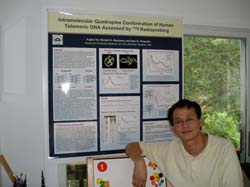
Prof. He Yujian
Do you feel drowsy sometimes in the afternoon? Do you seem to handle physical tasks more easily late in the day? If so, you already know about circadian rhythms. As a ubiquitous phenomenon, the circadian rhythms are only expected to be seen in a living system on the Earth. However, a CAS scientist claims it could also exist in a radioactive decay.
At the 40th International Union of Pure & Applied Chemistry (IUPAC) congress held in Beijing from August 14 to 19, Prof. He Yujian from the Graduate University of the CAS was invited to report his finding on the circadian rhythms in radioactive decay. According to him, a natural force field with periodicity and chirality exists on the Earth. It leads to the appearance of circadian rhythms in both living and non-living systems, also, giving rise to symmetry breaking (violation) on different levels.
At the meeting, Prof. He made a briefing on his data: In the beta-decay of the radionuclide Co60, for example, the radioactive strength's change as time progresses is not a smooth descending curve as the traditional concept puts it. Actually, the decaying regularity has a 24-hour period just like the pulsating movement of a heart. This indicates the weak force which governs the weak interaction is rhythmic. The phased position of the circadian rhythm in radioactive decay is dependent on the time zone in which the experimental measurement is located. This fact reveals the periodic force comes from an external source rather than an internal factor in radionuclide. The fact reminds Prof. He of the chiral force field induced by the Earth's Orbital Chirality (EOC), in which he is so interested. The EOC is mainly created by two natural helical motions: both the Earth's right handed helical rotation around its spin rotation axis and the Earth's right-handed helical revolution around the Sun. When combined with the Sun's motion in space and time, both the Earth's motions (rotation and revolution) are chiral and superhelical. The Earth's orbital chirality force field is mainly featured with both right-handed helical asymmetry and a 24-hour period.
Originating from radioactive isotopes of chemical elements, the β decay is caused by the so-called weak force. The weak force is the only asymmetrical one among the four fundamental forces (gravitational force, electromagnetic force, strong force and weak force) in the physical world. Many creative physicists, including A. Einstein, attempted to unify the four forces but in vain. "Could may the weak force come from the Earth"s orbital chirality force field?" asks Prof. He. Further tests enable him to see the positive or negative impact imposed by the external right- or left-handed helical force field on the half-life time of radioactive decay. So it is understandable that there were circadian rhythms in radioactive decay in the right-handed helical EOC force field with 24-hour period. In addition, Dr. He made theoretical computation and proved the weak force and the chiral force field have the same effect in terms of their magnitude. In the natural right-handed EOC force field, the left-handed helical spinning particles have higher energy than that of right-handed helical spinning particles. The former can be more easily emitted from the atomic nuclei, thus, parity violation comes into being. At this junction, Dr. He boldly suggests that the weak force may only be a form of the EOC force field at the microscopic particle level, and in essence, it is a kind of gravitational forces.
According to Prof. He's exposition, just like common chiral particles, the chiral EOC force field can make left-handed helical molecules to have higher energy than right-handed helical molecules. So, life on the Earth would prefer the right-handed helical molecular structures with lower energy (such as proteins composed of L-amino acids and nucleic acids composed of D-riboses) above their left-handed helical enantiomers (the proteins composed of D-amino acids and nucleic acids composed L-riboses). This is to say, in the origin of terrestrial life, L-amino acids and D-riboses were first chosen by the primitive life to organize right-handed helical proteins and nucleic acids which have more stable structures in the natural EOC force field. In the same way, living beings would be tending to choose right-handed helical structures to express their macroscopic forms such as the snail, shell and lianoid plants.
Prof. He further elucidates his hypothesis, claiming the EOC force field should be the cause of both origin of symmetry breaking (violation) and biological rhythms on various levels on the Earth. By using the hypothesis, a lot of long-standing puzzles, such as the origin of the molecular homochirality, origin of biological clock, origin of Junk DNA and the essence of the driving force of the biomolecular evolution, may be unified and solved.
The bi-annual IUPAC congress is one of the largest and most influencing get-togethers for worldwide chemists. This UIPAC congress is presided over by Prof. Bai Chunli, vice president of the CAS and chairperson of China Society of Chemistry. The next congress is to be held in Italy in August 2007.





